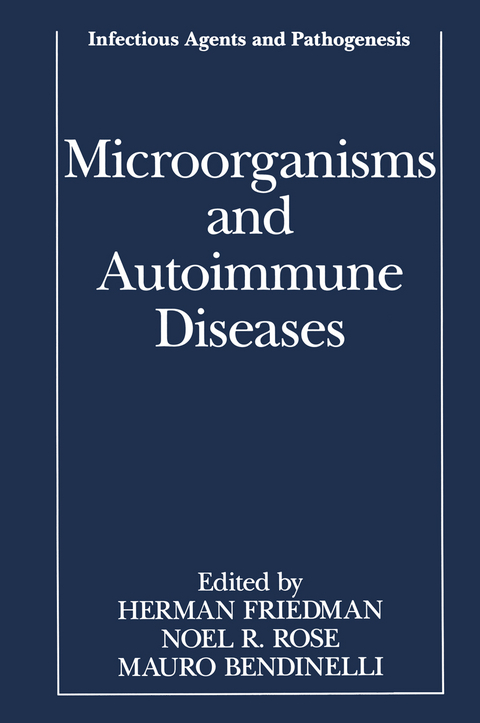
Microorganisms and Autoimmune Diseases
Springer-Verlag New York Inc.
978-1-4613-8009-2 (ISBN)
Experts in microbiology and autoimmunity examine the association between microorganisms and the development of specific categories of autoimmune diseases. The opening chapters explore the bacterial induction of diseases considered autoimmune in nature. Subsequent chapters describe the role of viruses in the induction of these diseases and of diseases with an autoimmune component. Specific topics include: the role of streptococcal infection in rheumatic fever and the role of Klebsiella in the development of ankylosing spondylitis.
1. Bacterial Heat-Shock Proteins and Autoimmune Disease.- 1. Introduction.- 2. Peripheral Tolerance, Autoimmunity, and Environmental Bacteria.- 3. Experimental Models Support a Critical Role of Specific Immunity in Autoimmune Diseases.- 4. HSP60 and the Inhibition of Experimental Arthritis.- 5. Responses to Human HSP60 in Juvenile Chronic Arthritis.- 6. Lessons for the Development of Specific Immunotherapy in Autoimmunity.- References.- 2. Streptococci and Rheumatic Fever.- 1. Introduction.- 2. Historical Perspective.- 3. Clinical Features.- 4. Etiology: The Group A Streptococcus.- 5. Epidemiology and Host Susceptibility.- 6. Autoimmune Pathogenesis of Acute Rheumatic Fever.- 7. Animal Models of Rheumatic Heart Disease.- 8. Treatment and Prevention.- References.- 3. HLA-B27, Enteric Bacteria, and Ankylosing Spondylitis.- 1. Introduction.- 2. One- and Two-Gene Theories.- 3. Description of HLA-B27-Associated Disease Markers in the Pathogenesis of Ankylosing Spondylitis.- 4. Evidence for HLA-B27-Restricted Cytotoxic T Lymphocytes in the Pathogenesis of Ankylosing Spondylitis and Other Seronegative Arthropathies.- 5. Conclusions and Future Directions.- References.- 4. Triggering of Autoimmune Antibody Responses in Syphilis.- 1. Introduction.- 2. Overview of the Disease.- 3. Immune Complexes and Autoimmune Responses in Syphilis.- 4. Polyclonal B-Cell Activation.- 5. Idiotypic Networks.- 6. Molecular Mimicry.- 7. Concluding Remarks.- References.- 5. Viruses and Diabetes Mellitus.- 1. Introduction.- 2. Viruses and Autoimmune Diabetes.- 3. Interferon and Diabetes.- 4. Molecular Mimicry between Viruses and Beta-Cell Autoantigens.- 5. Transgenic Models of Virus-Induced Diabetes.- 6. Concluding Remarks.- References.- 6. The Role of Coxsackie B Viruses in the Pathogenesis of Type IDiabetes.- 1. Introduction.- 2. Epidemiological Studies.- 3. Difficulties Encountered in Epidemiological Studies on the Relationship between Coxsackie B Viral Infections and IDDM.- 4. Case Reports and in Vitro Studies on Human Islet Cells.- 5. Animal Studies.- 6. Mechanisms for Coxsackie B Virus-Induced Diabetes.- 7. Concluding Remarks.- References.- 7. Neuropathic Viruses and Autoimmunity.- 1. Neurotropic Infection.- 2. Virus Entry and Infection.- 3. Acute Infection.- 4. Persistent Viral Infections.- 5. Viral Complications of Immunosuppression.- 6. Parainfectious Syndromes.- 7. Discussion and Conclusions.- References.- 8. Postmeasles Encephalomyelitis.- 1. Introduction.- 2. Postmeasles Encephalomyelitis.- 3. Viral Induction of Autoimmune Disease.- 4. Autoimmune Destruction of Myelin.- 5. Additional Mechanisms of Viral Demyelination.- 6. Conclusion.- References.- 9. Epstein-Barr Virus and Autoimmunity.- 1. Introduction.- 2. The Epstein-Barr Virus.- 3. EBV-Related Diseases.- 4. Autoimmune Diseases Possibly Related to EBV.- 5. Autoimmunity in Infectious Mononucleosis.- 6. Conclusions.- References.- 10. Retroviruses and Autoimmunity.- 1. Introduction.- 2. Retroviruses and Autoimmune Disease.- 3. General Biology of Retroviruses.- 4. Classic Autoimmune Disorders and Associations with Retroviruses.- 5. Summary.- References.- 11. Autoimmunity in Chagas Disease.- 1. Introduction.- 2. Uncommon Molecular Features of Trypanosoma cruzi.- 3. The Paradox of Antigen-Driven Delayed-Type Hypersensitivity.- 4. The Paradox of the Severe Forms of Acute Chagas Disease in Santiago del Estero Infants.- 5. Downregulation of the Immune Response.- 6. Autoreactive Organ-Specific Delayed-Type Hypersensitivity and Autoantibodies.- References.- 12. Infection and Endocrine Autoimmunity.- 1. Introduction.- 2. The Potential Role of Infection in Autoimmunity.- 3. Autoimmune Thyroid Disease.- 4. Pituitary and Polyendocrine Autoimmunity.- 5. Conclusion.- References.- 13. Infection as a Precursor to Autoimmunity.- 1. Introduction.- 2. Myocarditis.- 3. An Animal Model of Myocarditis.- 4. Genetics of Autoimmune Myocarditis.- 5. The Role of Cytokines.- 6. Myosin as Autoantigen.- 7. Discussion.- References.
| Reihe/Serie | Infectious Agents and Pathogenesis |
|---|---|
| Zusatzinfo | 26 Illustrations, black and white; XXI, 298 p. 26 illus. |
| Verlagsort | New York, NY |
| Sprache | englisch |
| Maße | 152 x 229 mm |
| Themenwelt | Medizin / Pharmazie ► Medizinische Fachgebiete ► Mikrobiologie / Infektologie / Reisemedizin |
| Studium ► Querschnittsbereiche ► Infektiologie / Immunologie | |
| Naturwissenschaften ► Biologie ► Botanik | |
| Naturwissenschaften ► Biologie ► Ökologie / Naturschutz | |
| Naturwissenschaften ► Biologie ► Zoologie | |
| ISBN-10 | 1-4613-8009-X / 146138009X |
| ISBN-13 | 978-1-4613-8009-2 / 9781461380092 |
| Zustand | Neuware |
| Haben Sie eine Frage zum Produkt? |
aus dem Bereich


